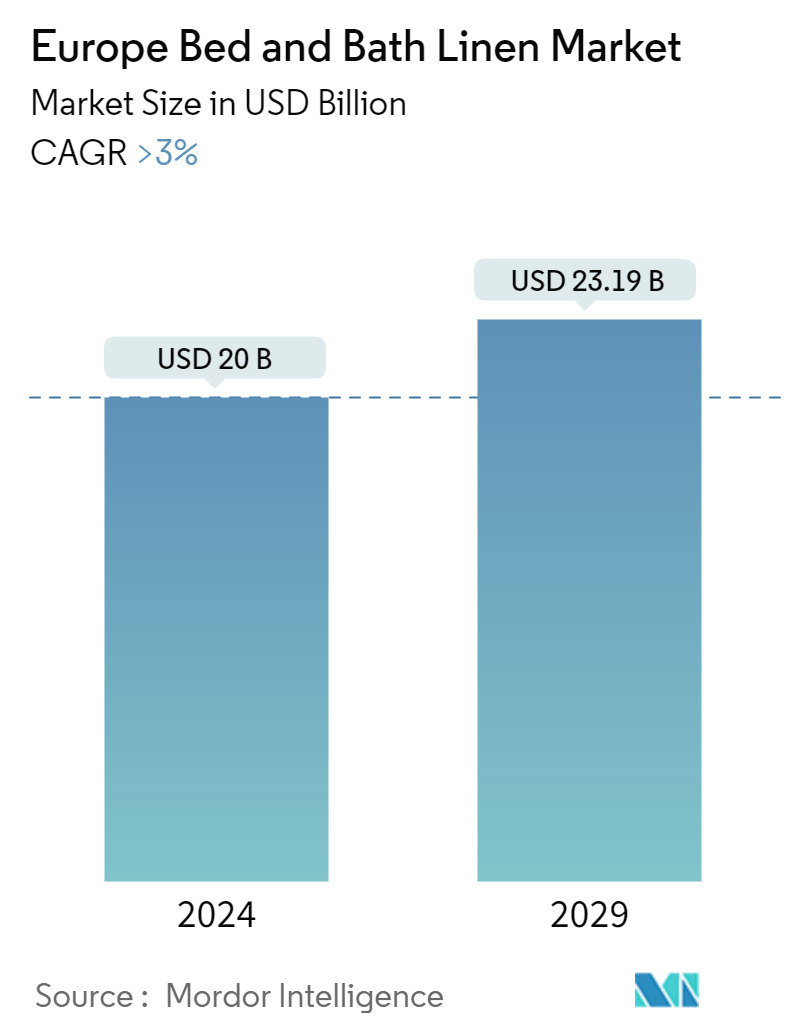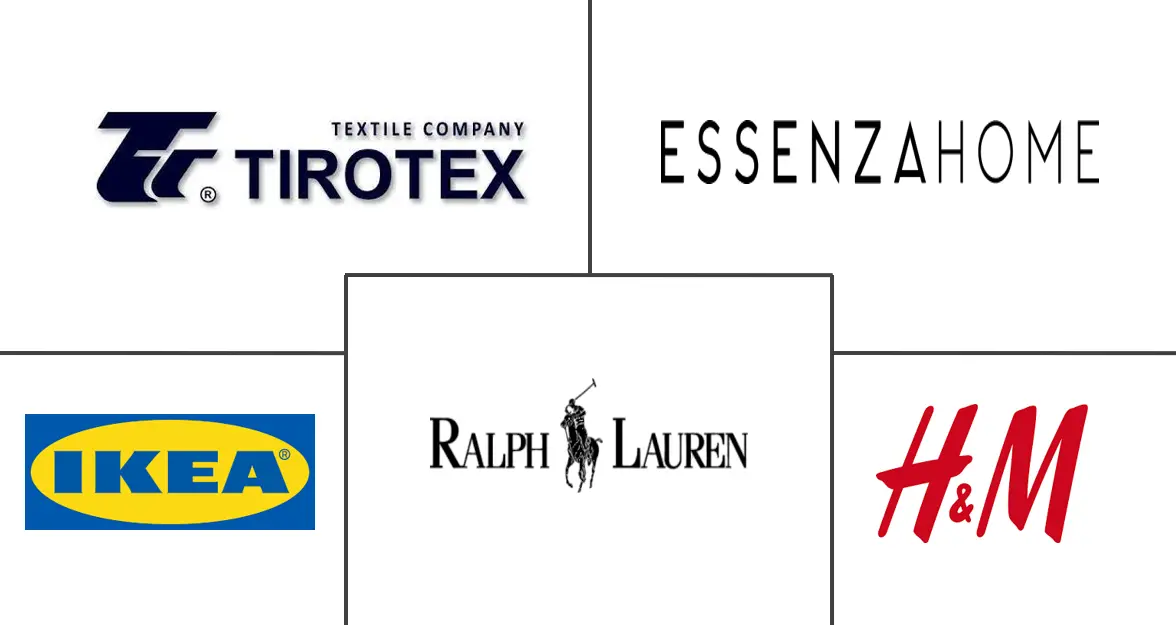Market Size of Europe Bed And Bath Linen Industry

| Study Period | 2020 - 2029 |
| Base Year For Estimation | 2023 |
| Market Size (2024) | USD 20 Billion |
| Market Size (2028) | USD 23.19 Billion |
| CAGR (2024 - 2029) | 3.00 % |
| Market Concentration | Medium |
Major Players
*Disclaimer: Major Players sorted in no particular order |
Europe Bed and Bath Linen Market Analysis
The Europe Bed And Bath Linen Market size is estimated at USD 20 billion in 2024, and is expected to reach USD 23.19 billion by 2028, growing at a CAGR of greater than 3% during the forecast period (2024-2028).
The market is witnessing growth propelled by an expanding housing sector, increased consumer spending on home furnishings, and a growing awareness of the physical and mental health benefits associated with sufficient sleep. The demand for larger beds and mattresses, coupled with an increasing preference for eco-friendly products, particularly those crafted from organic materials, is shaping market trends.
In response to evolving consumer preferences, there is a rising inclination toward diverse designs and patterns, including embroidered covers. Customers seek high-quality, stylish bed linens that offer versatility, contributing significantly to the industry's expansion. Additionally, the market is experiencing a surge in demand for luxury bath linens, such as hammam towels, especially within the home textiles market in Western Europe. Recent market drivers and opportunities encompass the adoption of sustainable practices, innovative design trends, and the integration of advanced technologies, shaping the landscape of the Europe Bed & Bath Linen Market.
Europe Bed and Bath Linen Industry Segmentation
Bed and bath linens consist of a variety of products that range from sheets and covers that are used in bedding to the linens used for the bathroom bath mat.
The European bed and bath linen market is segmented by product, distribution channel, end-user, and country. By product, the market is sub-segmented into bed linen and bath linen. By distribution channel, the market is sub-segmented into specialty stores, supermarkets, hypermarkets, online, and other distribution channels. By end user, the market is sub-segmented into residential and commercial. By country, the market is sub-segmented into the United Kingdom, France, Italy, Germany, and the rest of Europe. The report offers market size and forecasts for the Europe bed and bath linen market in value (USD) for all the above segments.
| By Product | |
| Bed Linen | |
| Bath Linen |
| By End User | |
| Residential | |
| Commercial |
| By Distribution Channel | |
| Speciality Stores | |
| Supermarkets and Hypermarkets | |
| Online | |
| Other Distirubution Channels |
| By Country | |
| United Kingdom | |
| France | |
| Italy | |
| Germany | |
| Rest of Europe |
Europe Bed And Bath Linen Market Size Summary
The Europe Bed and Bath Linen Market is experiencing a notable expansion, driven by factors such as the burgeoning housing sector and increased consumer expenditure on home furnishings. This growth is further fueled by a heightened awareness of the benefits of adequate sleep, both physically and mentally. The market is witnessing a shift towards larger beds and mattresses, alongside a growing preference for eco-friendly products, particularly those made from organic materials. Consumers are increasingly seeking diverse designs and high-quality, stylish bed linens that offer versatility, which is significantly contributing to the industry's growth. The demand for luxury bath linens, such as hammam towels, is also on the rise, particularly in Western Europe, as part of the broader home textiles market. The adoption of sustainable practices, innovative design trends, and advanced technologies are key drivers shaping the market landscape.
The market is characterized by its competitive and fragmented nature, with a mix of small and medium enterprises and prominent players like IKEA. The United Kingdom stands out with a significant share of bed linen consumption, driven by a preference for organic textiles. The industry is also witnessing a trend of manufacturers and retailers relocating production to low-cost countries, such as China and India, to source raw materials and products. Key suppliers in the sector include Dorma, Vanguard Textiles, and Arthur Sanderson for bed linens, and Christy and Stott & Smith for towels. Recent developments, such as Archroma's acquisition of Huntsman's Textile Effects business and H&M's joint venture with Remondis, highlight the industry's focus on sustainability and recycling initiatives. Despite the competitive landscape, the market continues to grow, supported by increasing disposable incomes and the resulting rise in consumer spending on quality goods and services.
Europe Bed And Bath Linen Market Size - Table of Contents
-
1. MARKET DYNAMICS AND INSIGHTS
-
1.1 Market Overview
-
1.2 Market Drivers
-
1.3 Market Restraints
-
1.4 Industry Value Chain Analysis
-
1.5 Industry Attractiveness - Porter's Five Forces Analysis
-
1.5.1 Bargaining Power of Buyers
-
1.5.2 Bargaining Power of Suppliers
-
1.5.3 Threat of New Entrants
-
1.5.4 Threat of Substitutes
-
1.5.5 Intensity of Competitive Rivalry
-
-
1.6 Insights of Technology Innovations in the Market
-
1.7 Impact of COVID-19 on the Market
-
-
2. MARKET SEGMENTATION
-
2.1 By Product
-
2.1.1 Bed Linen
-
2.1.2 Bath Linen
-
-
2.2 By End User
-
2.2.1 Residential
-
2.2.2 Commercial
-
-
2.3 By Distribution Channel
-
2.3.1 Speciality Stores
-
2.3.2 Supermarkets and Hypermarkets
-
2.3.3 Online
-
2.3.4 Other Distirubution Channels
-
-
2.4 By Country
-
2.4.1 United Kingdom
-
2.4.2 France
-
2.4.3 Italy
-
2.4.4 Germany
-
2.4.5 Rest of Europe
-
-
Europe Bed And Bath Linen Market Size FAQs
How big is the Europe Bed and Bath Linen Market?
The Europe Bed and Bath Linen Market size is expected to reach USD 20 billion in 2024 and grow at a CAGR of greater than 3% to reach USD 23.19 billion by 2028.
What is the current Europe Bed and Bath Linen Market size?
In 2024, the Europe Bed and Bath Linen Market size is expected to reach USD 20 billion.

